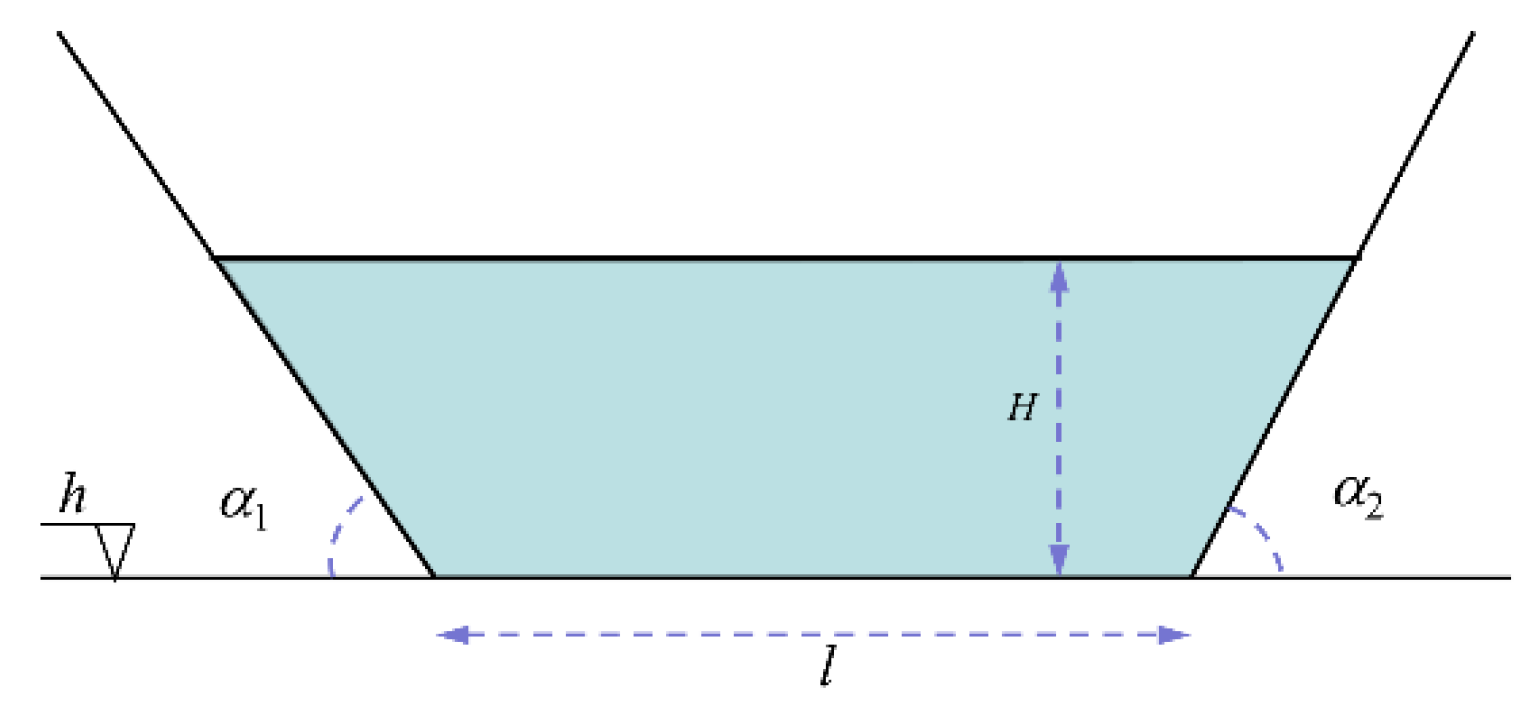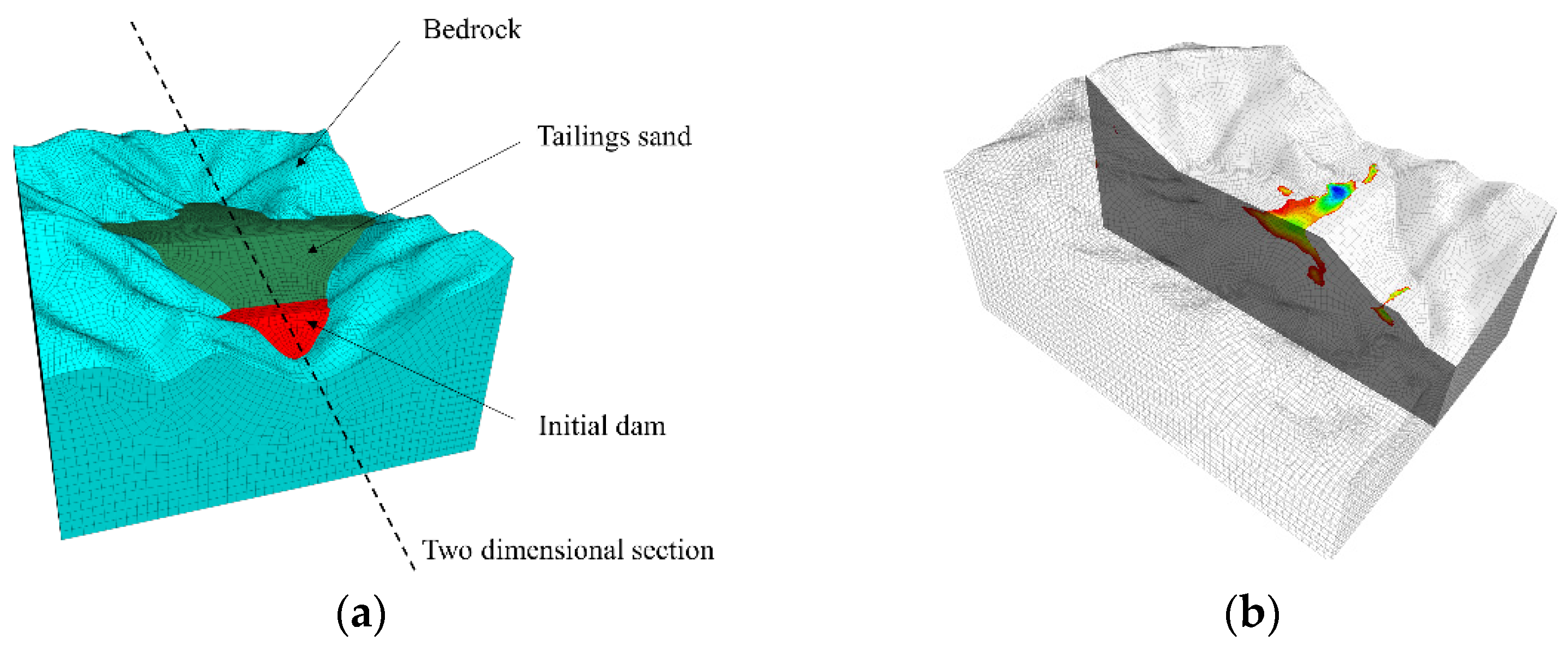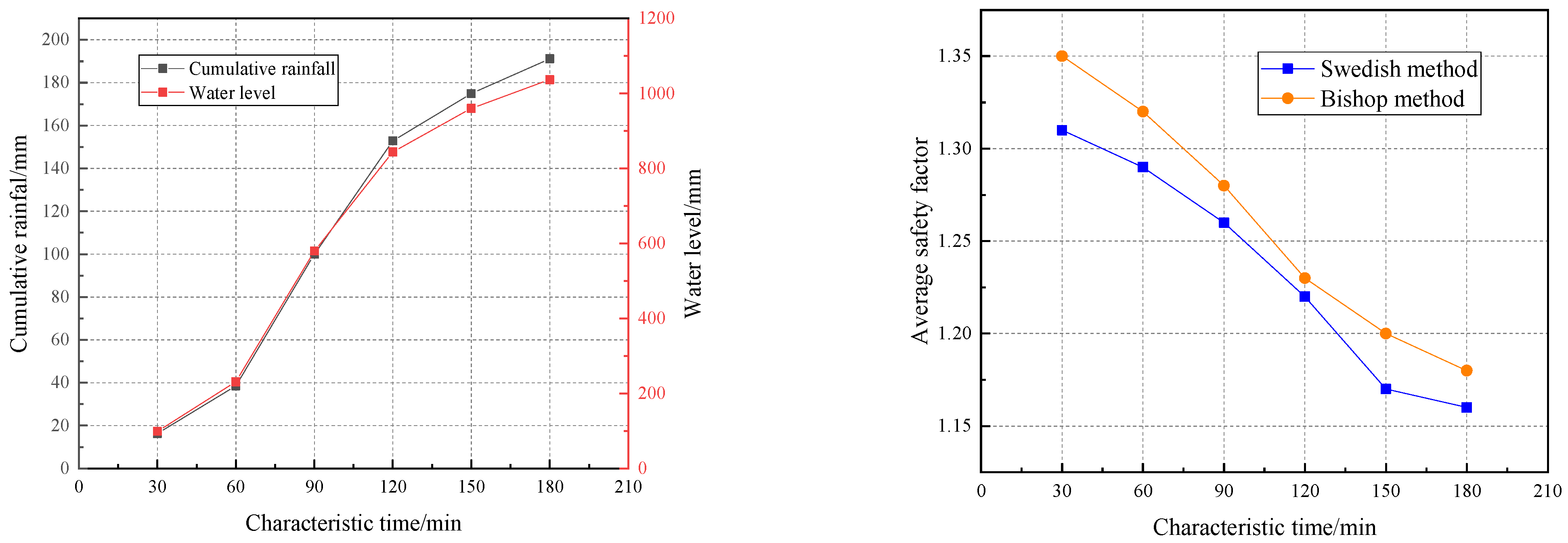Solution and Stability Analysis of Sliding Surface of Tailings Pond under Rainstorm
Abstract
1. Introduction
2. Limit Strain Monte Carlo Stability Analysis Method for Rainfall Slope of Tailings Pond
2.1. Boundary Parameters of Rainfall Model for Tailings Pond
2.2. Solution of Potential Sliding Surface of Tailings Pond Slope by Limit Strain Method
2.3. Monte Carlo Stochastic Expression and Reliability Solution of Geotechnical Parameters
2.4. Ultimate Strain Monte Carlo Reliability Analysis Method
3. Field Case Analysis
3.1. Rainfall Slope Model and Parameter Setting of Tailings Pond
3.1.1. Model Establishment
3.1.2. Model Parameters and Rainfall Boundary Conditions
3.2. Stability Analysis of Tailings Pond under Rainstorm
3.2.1. Water Level Line Calculation
3.2.2. Potential Sliding Surface Solution
3.2.3. Reliability Calculation
4. Discussion
5. Conclusions
- The conclusion of the limit strain Monte Carlo reliability analysis method of tailings pond are: Based on the analysis of hydrogeological rainstorm, the calculation method of trapezoidal generalized section water level in the flood process of tailings pond is proposed, and the rainfall boundary for the stability calculation of tailings pond in rainstorm area is obtained. Taking the limit strain as the criterion, the solution method of potential sliding surface of tailings pond is put forward, which is verified and analyzed by different criteria and experiments. Monte Carlo parameter randomness sampling method is used to deal with the randomness of geotechnical parameters.
- Through the analysis of the numerical simulation results in the case, it is found that the water level line in the tailings pond shows an upward trend with time, and the water level line in the bedrock also shows an increasing trend with time. The shape of the sliding surface of the part of the tailings pond in contact with the bedrock is close to that of the bedrock. With the continuous evolution of rainfall process, affected by the expansion of water level line and the gradual increase of tailing sand parameter softening area, the failure area of tailing pond slope is also expanding, but the position change of potential sliding surface is small.
- The stability of the tailings pond under the 180 min rainstorm with a return period of 100 years is analyzed, and the solution shows that the average safety factor of the tailings pond in the calculation example is 1.16 and 1.18, which meets the requirements of the rainstorm working condition specification. The failure probability of the whole rainfall process increases from 0.82% and 0.64% to 1.71% and 1.37%, and the failure probability of rainfall completion is more than doubled. The reliability index and the commonly used safety factor are unified in judging the stability of the tailings pond, and their drastic changes are concentrated in the middle of rainfall. Therefore, the middle of rainfall is the key node affecting the stability design of tailings ponds.
Author Contributions
Funding
Institutional Review Board Statement
Informed Consent Statement
Data Availability Statement
Conflicts of Interest
References
- World Information Service on Energy. Available online: https://www.wise-uranium.org/mdaf.html (accessed on 24 February 2022).
- Santamarina, J.C.; Torres-Cruz, L.A.; Bachus, R.C. Why coal ash and tailings dam disasters occur. Science 2019, 364, 526–528. [Google Scholar] [CrossRef] [PubMed]
- Lyu, Z.J.; Chai, J.R.; Xu, Z.G.; Qin, Y.; Cao, J. A comprehensive review on reasons for tailings dam failures based on case history. Adv. Civ. Eng. 2019, 9, 1–18. [Google Scholar] [CrossRef]
- Dai, H.; Qin, W.X.; Zhang, Y.A. Law of the Valley type tailings dam saturation line evolution under intensive rainfall. Metal Mine 2013, 445, 149–152. [Google Scholar]
- Dong, L.J.; Deng, S.J.; Wang, F.Y. Some developments and new insights for environmental sustainability and disaster control of tailings dam. J. Clean. Prod. 2020, 269, 122270. [Google Scholar] [CrossRef]
- Rotta, L.H.S.; Alcantara, E.; Park, E.; Negri, R.G. The 2019 Brumadinho tailings dam collapse: Possible cause and impacts of the worst human and environmental disaster in Brazil. Int. J. Appl. Earth Obs. Geoinf. 2020, 90, 102119. [Google Scholar] [CrossRef]
- Glotov, V.E.; Chlachula, J.; Glotova, L.P.; Little, E. Causes and environmental impact of the gold-tailings dam failure at Karamken, the Russian Far East. Eng. Geol. 2018, 245, 236–247. [Google Scholar] [CrossRef]
- Coulibaly, Y.; Belem, T.; Cheng, L.Z. Numerical analysis and geophysical monitoring for stability assessment of the Northwest tailings dam at Westwood Mine. Int. J. Min. Sci. Technol. 2017, 27, 701–710. [Google Scholar] [CrossRef]
- John, H.S. Estimating Slope Stability Reduction due to Rain Infiltration Mounding. J. Geotech. Geoenviron. Eng. 2006, 132, 1219–1228. [Google Scholar]
- Gui, R.; He, G.C. The Effects of Internal Erosion on the Physical and Mechanical Properties of Tailings under Heavy Rainfall Infiltration. Appl. Sci. 2021, 11, 9496. [Google Scholar] [CrossRef]
- Sun, Y.; Gu, X.W.; Xu, X.C. Experimental Study on Hydraulic Erosion Characteristics of Ecological Slope of Tailings Reservoir under Rainfall. KSCE J. Civ. Eng. 2021, 25, 2426–2436. [Google Scholar] [CrossRef]
- Wei, Z.A.; Yang, Y.H.; Zhao, H.J.; Chen, Y.L. Stability of tailings dam of Xiaodae tailings pond. J. North. Univ. 2016, 37, 589. [Google Scholar]
- Sitharam, T.G.; Hegde, A. Stability analysis of rock-fill tailing dam: An Indian case study. Int. J. Geotech. Eng. 2017, 11, 332–342. [Google Scholar] [CrossRef]
- Do, T.M.; Laue, J.; Mattsson, H.; Jia, Q. Numerical Analysis of an Upstream Tailings Dam Subjected to Pond Filling Rates. Appl. Sci. 2021, 11, 6044. [Google Scholar] [CrossRef]
- Hu, W.; Xin, C.L.; Li, Y.; Zheng, Y.S.; Asch, T.W.J.; McSaveney, M. Instrumented flume tests on the failure and fluidization of tailings dams induced by rainfall infiltration. Eng. Geol. 2021, 294, 106401. [Google Scholar] [CrossRef]
- Kong, X.Y.; Wang, G.J. Experiment Research on the Reinforced Triaxial Compression of Tailings Material and Infiltration Rainfall of Tailings Dam. J. Comput. Theor. Nanosci. 2016, 13, 6419–6423. [Google Scholar]
- Wang, G.J.; Yang, S.; Kong, X.Y.; Tang, Y.J. Study on the process and mechanism of indoor overtopping dam-failure of tailings dam model experiment under the rainfall. Meas. Control. 2016, 77, 86–97. [Google Scholar]
- Hanson, G.J.; Cook, K.R.; Hunt, S.L. Physical modeling of overtopping erosion and breach formation of cohesive embankments. Trans. ASAE 2005, 48, 1783–1794. [Google Scholar] [CrossRef]
- Zhang, C.; Chai, J.; Cao, J.; Xu, Z.G.; Qin, Y.; Lv, Z.J. Numerical Simulation of Seepage and Stability of Tailings Dams: A Case Study in Lixi, China. Water 2020, 12, 742. [Google Scholar] [CrossRef]
- Bu, L.; Zhou, H.M.; Li, C.H. Three-dimensional stability analysis of fine grained tailings dam with complex terrain by means of up-stream method. Electron. J. Geotech. Eng. 2016, 21, 3905–3920. [Google Scholar]
- Supandi. The Influence of Water Balance for Slope Stability on the High Mine Waste dump. Geotech. Geol. Eng. 2021, 39, 5253–5266. [Google Scholar] [CrossRef]
- Naeini, M.; Akhtarpour, A. Numerical analysis of seismic stability of a high centerline tailings dam. Soil Dyn. Earthq. Eng. 2018, 107, 179–194. [Google Scholar] [CrossRef]
- Hu, S.H.; Chen, Y.F.; Liu, W.; Zhou, S.; Hu, R. Effect of seepage control on stability of a tailings dam during its staged construction with a stepwise-coupled hydro-mechanical model. Int. J. Min. Reclam. Environ. 2015, 29, 125–140. [Google Scholar] [CrossRef]
- Wang, G.J.; Kang, J.W.; Du, C.; Tang, Y.J. Study on tailings dam over-topping failure model test and break mechanism under the rainfall condition. Teh. Vjesn. 2017, 24, 1897–1904. [Google Scholar]
- Wang, G.J.; Tian, S.; Hu, B.; Kong, X.Y.; Chen, J. An experimental study on tailings deposition characteristics and variation of tailings dam saturation line. Geomech. Eng. 2020, 23, 85–92. [Google Scholar]
- Sun, G.H.; Yang, Y.T.; Cheng, S.G.; Zheng, H. Phreatic line calculation and stability analysis of slopes under the combined effect of reservoir water level fluctuations and rainfall. Can. Geotech. J. 2017, 54, 631–645. [Google Scholar] [CrossRef]
- Zhang, C.; Liu, H.M.; Yang, C.H.; Wu, S.W. Mechanical characteristics of non-saturated tailings and dam stability. Int. J. Min. Reclam. Environ. 2017, 31, 530–543. [Google Scholar] [CrossRef]
- Jin, J.X.; Qin, Z.F.; Lv, X.L.; Liu, T.; Zhang, G.S.; Shi, J.Y. Rheology control of self-consolidating cement-tailings grout for the feasible use in coal gangue-filled backfill. Constr. Build. Mater. 2022, 316, 125836. [Google Scholar] [CrossRef]
- Zhang, D.; Jian, W.B.; Ye, Q.; Lin, W. Tailings slope time-varying analysis model and its application. Rock. Soil. Mech. 2014, 35, 835–840. [Google Scholar]
- Maldonado, F.M. Shear strength variation of tailings material due to meteorological causes and its influence on the physical stability of tailings dam No. 3 Mahr Túnel. Ind. Data 2019, 22, 50–60. [Google Scholar]
- Wang, X.G.; Zhan, H.B.; Wang, J.D.; Li, P. The stability of tailings dams under dry-wet cycles: A case study in Luonan, China. Water 2018, 10, 1048. [Google Scholar] [CrossRef]
- Xu, B.; Wang, Y. Stability analysis of the Lingshan gold mine tailings dam under conditions of a raised dam height. B Eng. Geol. Environ. 2015, 74, 151–161. [Google Scholar] [CrossRef]
- Gens, A.; Alonso, E.E. Aznalcollar dam failure part 2: Stability conditions and failure mechanism. Geotechnique 2006, 56, 185–201. [Google Scholar] [CrossRef]
- Salgueiro, A.R.; Pereira, H.G.; Rico, M.T. Application of correspondence analysis in the assessment of mine tailings dam breakage risk in the Mediterranean region. Risk. Anal. 2008, 28, 13–23. [Google Scholar] [CrossRef] [PubMed][Green Version]
- Clarkson, L.; Williams, D. An Overview of Conventional Tailings Dam Geotechnical Failure Mechanisms. Min. Metall. Explor. 2021, 38, 1305–1328. [Google Scholar] [CrossRef]
- Hancock, G.R. A method for assessing the long-term integrity of tailings dams. Sci. Total Environ. 2021, 779, 146083. [Google Scholar] [CrossRef] [PubMed]
- Dong, L.J.; Sun, D.Y.; Li, X.B. Theoretical and case studies of interval nonprobabilistic reliability for tailing dam stability. Geofluids 2017, 2017, 8745894. [Google Scholar] [CrossRef]
- Liang, Z.Y.; Liang, L.; Cai, Y.Z.; Bertoni, A. The influence factors of the stability of tailings dam based on multi-source information fusion method. J. Intell. Fuzzy Syst. 2019, 37, 3365–3372. [Google Scholar] [CrossRef]
- Maria, T.Z.; Luciano, A.O.; Roberto, R. The role of capillary water in the stability of tailing dams. Eng. Geol. 2009, 105, 108–118. [Google Scholar]










| Material | Bulk Density | Effective Stress Shear Index | Modulus of Elasticity E | ||||||||||
|---|---|---|---|---|---|---|---|---|---|---|---|---|---|
| Natural Bulk Density γ/kN·m−3 | Floating Bulk Density γ’/kN·m−3 | C/kPa | φ/° | ||||||||||
| Average Value | Standard Deviation | Average Value | Standard Deviation | MPa | |||||||||
| Average Value | Average Value | Average Value | Average Value | Water | Underwater | Water | Underwater | Water | Underwater | Water | Underwater | ||
| Initial dam | 18.0 | 0.2 | 10.0 | 0.2 | 0.0 | 0.0 | - | - | 28.0 | 27.0 | 3.4 | 3.4 | 120 |
| Tailing fine Sand | 17.5 | 1.2 | 9.6 | 1.3 | 0.0 | 0.0 | - | - | 26.5 | 24.6 | 3.8 | 4.0 | 45.8 |
| Tail silt | 16.9 | 0.5 | 9.2 | 0.6 | 21.4 | 15.7 | 4.4 | 4.5 | 24.6 | 22.1 | 3.4 | 3.7 | - |
| Sub dam | 20.5 | 0.2 | 12.3 | 0.2 | 12.1 | 5.6 | 1.8 | 1.9 | 29.0 | 26.0 | 2.0 | 2.2 | - |
| Bedrock | 24.0 | - | 24.0 | - | 30.0 | 280 | - | - | 38.0 | 35.0 | - | - | 160 |
| Duration | Rainfall/mm | |||||||
|---|---|---|---|---|---|---|---|---|
| 2 Years | 3 Years | 5 Years | 10 Years | 20 Years | 30 Years | 50 Years | 100 Years | |
| 1 h | 43.8 | 51.3 | 60.3 | 71.7 | 83.1 | 88.8 | 96.1 | 106.3 |
| 2 h | 57.8 | 69.2 | 83.4 | 101.4 | 118.7 | 127.4 | 138.8 | 154.6 |
| 3 h | 67.0 | 81.5 | 99.8 | 123.0 | 145.0 | 156.2 | 170.8 | 191.2 |
| … | … | … | … | … | … | … | … | … |
| 24 h | 99.1 | 116.3 | 135.0 | 157.9 | 179.0 | 190.7 | 205.1 | 224.1 |
| Calculation Results | ||||||
|---|---|---|---|---|---|---|
| Characteristic time node/min | 30 | 60 | 90 | 120 | 150 | 180 |
| Time history allocation proportion/% | 1.57 | 2.32 | 12.86 | 2.52 | 1.64 | 1.29 |
| Real time rainfall/mm | 3.00 | 4.43 | 24.59 | 4.82 | 3.14 | 2.47 |
| Cumulative rainfall/mm | 16.25 | 38.52 | 99.94 | 152.84 | 174.89 | 191.20 |
| Waterline height/mm | 99.15 | 231.15 | 579.64 | 843.69 | 960.05 | 1036.32 |
| Characteristic Time/min | Cumulative Rainfall/mm | Water Level/mm | Average Safety Factor Fμ | Reliability Index Fβ | Failure Probability Pf/% | |||
|---|---|---|---|---|---|---|---|---|
| Swedish Method | Bishop Method | Swedish Method | Bishop Method | Swedish Method | Bishop Method | |||
| 30 | 16.25 | 99.15 | 1.31 | 1.35 | 3.28 | 3.58 | 0.85 | 0.69 |
| 60 | 38.52 | 231.15 | 1.29 | 1.32 | 3.26 | 3.56 | 0.98 | 0.78 |
| 90 | 99.94 | 579.64 | 1.26 | 1.28 | 3.23 | 3.53 | 1.13 | 0.95 |
| 120 | 152.84 | 843.69 | 1.22 | 1.23 | 3.21 | 3.50 | 1.41 | 1.15 |
| 150 | 174.89 | 960.05 | 1.17 | 1.20 | 3.19 | 3.48 | 1.62 | 1.31 |
| 180 | 191.20 | 1036.32 | 1.16 | 1.18 | 3.18 | 3.47 | 1.71 | 1.37 |
Publisher’s Note: MDPI stays neutral with regard to jurisdictional claims in published maps and institutional affiliations. |
© 2022 by the authors. Licensee MDPI, Basel, Switzerland. This article is an open access article distributed under the terms and conditions of the Creative Commons Attribution (CC BY) license (https://creativecommons.org/licenses/by/4.0/).
Share and Cite
Wu, P.; Liang, B.; Jin, J.; Zhou, K.; Guo, B.; Yang, Z. Solution and Stability Analysis of Sliding Surface of Tailings Pond under Rainstorm. Sustainability 2022, 14, 3081. https://doi.org/10.3390/su14053081
Wu P, Liang B, Jin J, Zhou K, Guo B, Yang Z. Solution and Stability Analysis of Sliding Surface of Tailings Pond under Rainstorm. Sustainability. 2022; 14(5):3081. https://doi.org/10.3390/su14053081
Chicago/Turabian StyleWu, Pengfei, Bing Liang, Jiaxu Jin, Kelin Zhou, Bin Guo, and Zetao Yang. 2022. "Solution and Stability Analysis of Sliding Surface of Tailings Pond under Rainstorm" Sustainability 14, no. 5: 3081. https://doi.org/10.3390/su14053081
APA StyleWu, P., Liang, B., Jin, J., Zhou, K., Guo, B., & Yang, Z. (2022). Solution and Stability Analysis of Sliding Surface of Tailings Pond under Rainstorm. Sustainability, 14(5), 3081. https://doi.org/10.3390/su14053081






